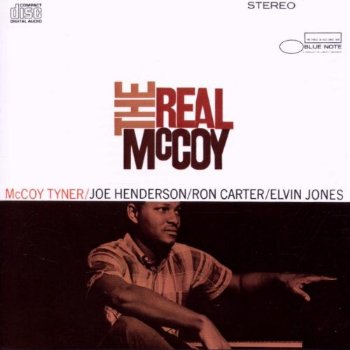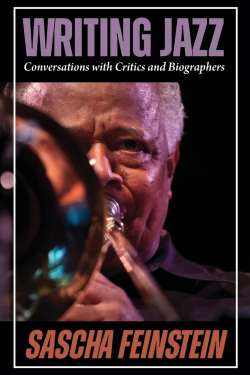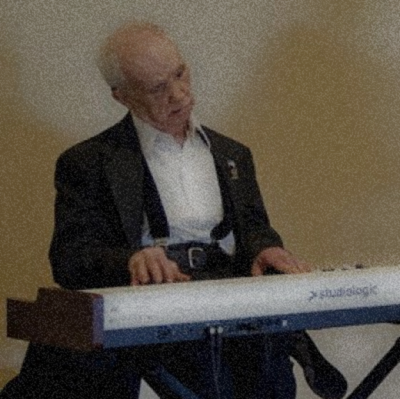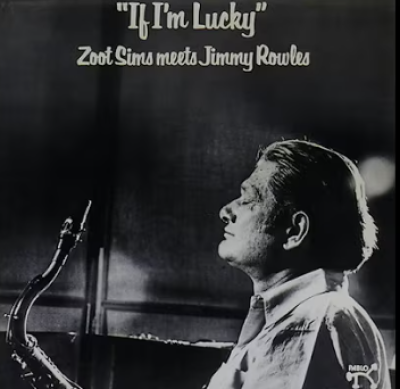
McCoy Tyner’s 1967 recording The Real McCoy was included in the lists of musician Robin Eubanks and journalist John Goodman as being among their favorite jazz record albums of the 1960’s
__________
“Reminiscing in Tempo” is part of a continuing effort to provide Jerry Jazz Musician readers with unique forms of “edu-tainment.” As often as possible, Jerry Jazz Musician poses one question via e mail to a small number of prominent and diverse people. The question is designed to provoke a lively response that will potentially include the memories and/or opinion of those solicited.
Since it is not possible to know who will answer the question, the diversity of the participants will often depend on factors beyond the control of the publisher. The responses from the people who chose to participate in this edition are published below with only minor stylistic editing. No follow-up questions take place.
_____
In this edition, we ask the question:
“What are 3 or 4 of your favorite jazz record albums of the 1960’s?”
*
(Readers are invited to participate by using the comments field at the conclusion of this feature)
_______________
The 60’s were full of great recordings, but here are the ones that marked me for life.
‘Kind of Blue’ from Miles Davis.
I know this album was released in 1959, but to me it is THE DEFINITIVE jazz recording of all time.
This recording introduced me not only to the poetic side of Miles, of whom I was already a fan, but to the great work of John Coltrane, Julian ‘Cannonball’ Adderly and pianist Bill Evans. These three men became my principal musical Gurus and have inspired me throughout my life.
‘A Love Supreme’ from John Coltrane.
At the time I first heard this recording, I was already a fan of Coltrane having listened to him on Miles Davis’ recordings since 1958. He had a huge impact on the way I ‘saw’ jazz. In addition I was making my first tentative steps towards some kind of self discovery. However, with this album, he not only created a new form in jazz, but also integrated for the first time, the spiritual dimension in jazz music. This had an impact on me that has lasted until today and will continue until my final day, perhaps beyond.
‘Sargent Pepper’ from the Beatles.
This choice may seem strange to you, but nevertheless, this album had a major impact on me. At the time of the release of this album, many of us musicians whether jazz, pop or other, were making first steps towards trying to address the big questions of life, and the Beatles also. It was how they addressed these questions, and found new ways of expression in lyrics or in music in answering these questions that endeared them to me.
I could go on citing great artists of the sixties such as James Brown or the band Sly and the Family Stone who also had a powerful impact on me musically, but the list would run too long.
______________
My favorite three jazz recordings from the 1960’s are (in order)1) Four & More (Miles Davis)
2) Miles Smiles (Miles Davis)
3) Empyrean Isles (Herbie Hancock)
“Yes I’m a vibraphonist but I’m very much a drummer, as well. The connection between Tony Williams and Ron Carter is just amazing. They’re like a tag team competing for a championship. They way the two of them play just elevates everybody from Miles, George Coleman, Wayne Shorter and Freddie Hubbard.”
________
(1) The Modern Jazz Quartet, European Concert (Atlantic, 1960)
(2) Paul Desmond and Gerry Mulligan, Two of a Mind (RCA, 1962)
(3) Bill Evans, Conversations with Myself (Verve, 1963)
(4) Miles Davis Quintet, Nefertiti (Columbia, 1967)
The turf, needless to say, is impossibly large, and I might pick four completely different albums if I were to answer this question later today, or next week. But I doubt if they’d all be different.
____________
Art Blakey and the Jazz Messengers – Free For All
McCoy Tyner – The Real McCoy
Wayne Shorter – Night Dreamer
John Coltrane – A Love Supreme
JJ Johnson – Proof Positive
________________
The 60’s are my era and choosing three or four is impossible, but here are the ten that first came to mind:
Ornette Coleman: Ornette!
Duke Ellington: Far East Suite
Gil Evans: Out of the Cool
Miles Davis: My Funny Valentine
Getz-Gilberto
Archie Shepp: Fire Music
Sonny Rollins on Impulse
John Coltrane: A Love Supreme
Cecil Taylor: Unit Structures
Jaki Byard Experience
_____________
1. Bill Evans Live at the Village Vanguard, Bill Evans (1961)
2. New York Tendaberry, Laura Nyro (1968)
3. Booker Little & Friends, Booker Little (1961)
______________
Some of my favorite ’60s jazz albums:Out to Lunch, Eric Dolphy’s masterpiece with six brilliant compositions, an extraordinary ensemble (especially featuring the contributions of Bobby Hutcherson and Tony WIlliams plus bassist Richard Davis, Freddie Hubbard stretching his imagination on trumpet and Dolphy making breakthroughs on flute, bass clarinet and alto);
Unit Structures, Cecil Taylor’s magnificent and unique ensemble album, still rich with sensuous mystery after 60 years;
Maiden Voyage, pianist-composer Herbie Hancock’s enduring pleasure, again with Hubbard and Williams, solid Ron Carter and saxophonist George Coleman’s most imaginative, fervid solos, an album that’s not avant-garde but perfectly balanced, melodic and expressive
Symphony for Improvisers, Don Cherry’s color-imbued two suites with Pharaoh Sanders on piccolo (!), tenor saxist Gato Barbieri in peerless counterpoint with Cherry, beautiful vibes/piano playing by Karl Berger and sublime drumming by Edward Blackwell (plus fascinating bass interplay by Henry Grimes and J.F. Jenny-Clark)
It’s a coincidence, maybe, that all these albums are on Blue Note, but I could easily name another 4 or 8 ’60s albums on that label of which I’m equally fond (stating with Taylor’s Conquistador, Cherry’s Complete Communion, Sam Rivers’ Contours, Andrew Hill’s Judgement). Of course I am enthralled by many other ’60s albums, too — this was my formative period, and Roscoe Mitchell’s Sound, Miles In A Silent Way, Mingus Mingus Mingus Mingus, Rip Rig and Panic, Inside Betty Carter, Coltrane’s Impressions just begin the list of the many recordings that caught my imagination and drew me into loving jazz in all its forms.
___________________
Clarinetist, saxophonist, composer, arranger, recording artist; social critic As a woodwind improviser, I tend to honor music that features saxophone players and these would be my favorites. These are recordings with solos that I have studied, notated and played on multiple instruments:
Les McCann & Eddie Harris “Swiss Movement” – the right music at the right time, recorded in 1969 (may have been released a bit later, but it’s a seminal 60’s sound)
Eddie Harris “The In Sound” – Ron Carter sounds amazing, and Eddie is the definition of versatility and real Soul
John Coltrane “A Love Supreme” – Black religious music delivered with concept, execution, poise
McCoy Tyner “The Real McCoy” – my favorite piano and tenor solos ever
Honorable mention: Lee Morgan “Delightfullee” – the record that made me want to play Jazz because it was the first time I heard Joe Henderson; I stole it from my parents’ basement, but it belonged to my Uncle Dan
_________________
1. J.J.Johnson – “Proof Positive” on Impulse
2. Miles Davis – ” Four and More” on Columbia
3. Art Blakey and the Jazz Messengers – “Ugetsu” on Riverside ?
4. John Coltrane – “Afto Blue” on Impulse
_________________
Favorite albums of the 1960s, in no particular order below…
Stan Getz-Getz/Gilberto
John Coltrane-A Love Supreme
Sonny Rollins-Alfie Soundtrack
Count Basie-Straight Ahead
______________
Gil Evans “Out of the Cool” (Impulse, 1960) Gil Evans “Individualism of Gil Evans” (Verve, 1964) Bob Brookmeyer “Gloomy Sunday and Other Bright Moments” (Verve, 1961) Bill Evans & Jim Hall “Undercurrent” (Blue Note, 1962)
There are a 100 other great options, but those are the ones that I’ve listened to for the past couple weeks and always find myself returning to them quite often.
__________
Here are records by four famous jazz pianists, two of them rather obvious choices, two perhaps not.
1. Waltz for Debby (1961): Bill Evans, with Scott LaFaro and Paul Motian. Most everybody who loves jazz knows this record or at least some of the tunes. It is the classic outing for this great trio. Debby helped me get through a bad case of the blues at a couple of different times in my life. In particular, the moody swing-and-sadness of “Detour Ahead” was a tune to submerge in. Leonard Bernstein’s “Some Other Time” conveyed sentiment without sentimentality, an Evans trademark. So much of Evans’ music is infused with a sense of working through sadness.
2. Now He Sings, Now He Sobs (1968): Chick Corea, with Miroslav Vitous and Roy Haynes. This record blew me away when I first reviewed it in March 1969: ” . . . easily one of the most beautiful and technically accomplished discs in the world of post-Bill Evans piano.” To those who were listening, this was a major breakthrough in modal jazz that really put Chick on the map. The original LP came with only five songs. In 2002, Blue Note-Capitol put out a remastered 24-bit CD with all 13 of the trio’s pieces.
3. The Real McCoy (1967): McCoy Tyner, with Joe Henderson, Ron Carter and Elvin Jones. After his years with John Coltrane, McCoy Tyner put together this amazing quartet which built new modal structures on McCoy’s earlier Coltrane approach. Some of your Tyner favorites got their first outing here, namely “Passion Dance,” “Search for Peace,” and “Blues on the Corner.”
4. Live at the It Club (1964): Thelonious Monk, with Charlie Rouse, Larry Gales and Ben Riley. Monk was finally achieving some public success by the mid-’60s and, in fact, never played better than in these recordings. Columbia reissued all the It Club material in a two-disc CD set in 1998, and this was Monk’s house band, more or less, for several years. I don’t dig Larry Gales’s monotonous thump-thump bass playing, but this quartet provides the sound Monk wanted to set off his particular genius.
Continue to the next page to read more











































A big yes to Shelley Manne’s 2-3-4…a classic!
I guess I have to do some listening here…I don’t know this album. My favorite Manne recording is “My Fair Lady,” but if memory serves that was a mid-50’s recording. I do like the “At the Manne-Hole” album from the early 60’s though…
Recorded in 60, released in the 70s: Mingus at Antibes
Most personally resonant lists: Don Byron, Marc Myers. Honorable mention: Ryan Truesdell
Great post idea, thanks
Thanks…If you have a question idea for a future edition, please feel free to pass it along!
I’m just amazed that no one has chosen “Forest Flower” Keith Jarrett,Charles Lloyd etc. extraordinary music,which delights year after year
I am somewhat surprised by this as well, but man, there were so many incredible albums from the 60’s.
Yes to John Coltrane’s Crescent, Duke Ellington’s Far East Suite, Gill Evans Out of the Cool, and Sonny Rollins The Bridge
Four of my personal favorites:
1. Stanley Turrentine Joyride- Classic hard bop with Herbie Hancock and Kenny Burrell swinging some R&B chestnuts with arrangements by Oliver Nelson.
2. Oliver Nelson Blues and the Abstract Truth
3. John Handy Live at Monterrey
4. John McLaughlin Extrapolation
I like your choices…especially the Oliver Nelson album, which surprises me that it wasn’t on anyone’s list. “Teenie;s Blues” is a great tune.
I’ve always had fond memories of the John McLaughlin album. I bought it as a teen in the mid 1980’s at a jazz record store in Philadelphia along with John Coltrane Crescent. The rock drumming legend Bill Bruford mentioned Extrapolation as an album he listened to for inspiration in a Modern Drummer interview back then. Binky’s Beam, It’s Funny and Arjen’s Bag still hold up as some of John McLaughlin’s finest compositions. The first two jazz albums I ever bought and I still listen to them.
I find it strange that no one else included “Rah,” the first album by Mark Murphy which really showed off his jazz vocal chops. Three other personal favorites are as follows:
“Blues and the Abstract Truth” – Oliver Nelson (The charts are still among the most thrilling I’ve ever heard. Ironically, though, I first heard “Stolen Moments” as the background to a commercial for a radio show, “The Apartment Gardener”!)
“Maiden Voyage” – Herbie Hancock (My introduction to the power of Herbie’s music, as well as the playing of Freddie Hubbard.)
“The Gigolo” – Lee Morgan (I first heard the title track, “Yes I Can, No You Can’t,” played by DJ Ed Beach on WRVR. To this day, “The Gigolo” is one of those albums guaranteed to lift me, when I’m going through a blue period.)
Yes…”Maiden Voyage” seems like it should be on more lists…
Miles – Nefertiti
Miles – In a Silent Way
Coltrane – Crescent
Rollins – The Bridge
Not the most adventuresome picks, but 4 that I will never get tired of hearing.
All have made it to my turntable, and they all still sound good to this day.
I’d really like to call bluff on those ‘Unit Structures’ mentions. Do these people hum along with that? No, really! Or perhaps I should say: these folks must have something more hummable in their collections that they enjoy more than Unit Structures. Perhaps these surveys should be anonymous, so that no extraneous motives can sneak in. I’m all for avant-garde but I’ve never understood the appeal of Cecil Taylor.
Cecil isn’t for everyone, for sure, but Unit Structures is pretty accessible…What is an example of an album from the 60’s that you like?
Well, in addition to many of the names already mentioned by others, how about Booker Little (underrated, imo; listen for instance to the track Victory and Sorrow on Booker Little and Friends), or Jackie McLean, or Andrew Hill, for instance. Or Sam Rivers’ Fuchsia Swing Song. Or some of Anthony Braxton’s more accessible stuff. Hell, even with people like Albert Ayler or Marion Brown, it’s easier to see what they’re up to than Cecil Taylor (in my opinion). But perhaps I should just give Unit Structures another listen.
Unit Structures was one of the first jazz albums I ever bought, in 1971 — a mono cutout copy for 99 cents from the A&P a block from my house. I had seen the name somewhere and the liner notes together with the cover design aroused my curiosity. I was a young underground rock fan just beginning to explore jazz, and this album took my head apart and reassembled it ways I never recovered from (the only thing that came close in my experience were the little piano bits in King Crimson’s “Cat Food”). I still consider it one of the greatest albums of the time, and one of my most profoundly life-changing musical experiences.
CT’s music is hard for some to justify as jazz, but even when those roots are not overt, they are implied. It’s as if an abstract painter created a realistic landscape and painted over it in a freer fashion. The finished product would not have been the same without the initial framework. CT came out of jazz and never really left it, however far out he went. Same is true for Trane, whose later music leaves some cold; that later stuff was the first Trane many of us who came to jazz in the 1970s heard because it was the most recent and still being posthumously released. For me, apart from a falling off due probably to illness and exhaustion at the end, Coltrane’s music steadily evolved and moved forward, building on what came before, until it reached a kind of nirvana.
Hard to disagree with Miles and Trane, and for me that would be Nefertiti and A Love Supreme, if I could only choose one. Next would be Bill Evans Sunday at the Vanguard (or, why not, the whole Vanguard set), Eric Dolphy’s “Out to Lunch”, Andrew Hill’s “Black Fire” or “Point of Departure” (I can’t choose) and Cecil Taylor “Unit Structures”. A little of everything, and perhaps Randy Weston’s “African Cookbook” to bring it all home.
Chick Corea’s “Sundance”, Lee Morgan’s “The Procrastinator”, (which was released in the 1970’s, but recorded on various dates of the 1960’s), Bill Evans’ “Trio ’64” and Dexter Gordon’s “Go!”.
Surprised no mention of Larry Young’s “Unity” Not only for the music but also for the great album cover, one of Reid Miles best.
I’ll toss Herbie Hancock’s “Speak Like A Child” into the mix. It’s understated and remains very listenable.
I can’t argue with those who suggest Oliver Nelson’s “Blues and the Abstract Truth.”
Lee Morgan’s “Search For The New Land” has to be on my list.
And these three titles just made me think of ten more. This is a great exercise. It got me to dig deep into the collection and I’m sure many others did the same.
LIke some say, each day would bring different entries, but these would stay consistent:
A Love Supreme
Spiritual Unity
Roland Kirk’s Inflated Tear
Mingus’ Black Saint and the Sinner Lady
Impossible task only picking 3 or 4. Here are a few of my favorites (and I’m deliberately not picking albums from Trane or Miles as they would have 3 or 4 each):
1.) Booker Ervin – the “Book” series – Freedom, Space, Blues, and Song Book albums. All awesome.
2.) Hank Mobley – Soul Station. Really cool to hear him in a quartet setting and some great playing throughout. Also love A Slice of The Top. That one is in a larger ensemble setting and includes great piano from McCoy Tyner.
3.) Booker Little – Out Front. Never get tired of this album. This one is on my turntable at home now.
4.) Wayne Shorter – JuJu. Some of my favorite tunes by Wayne are on this one.
And I’ve already used up my 3 or 4 and haven’t even mentioned Art Blakey, Freddie Hubbard, Sonny Rollins (Newk’s Time), Wes Montgomery (Incredible Jazz Guitar) …..
Greg, I like the way you eliminated the “obvious” choices and focused instead on the “secondary” players. I don’t think anyone else has taken that approach. Nice list!
Great selections from everyone – makes me want to dig out things I have not listened to for a while. Here are my choices:
Mulligan Concert Jazz Band, Zurich 1960 – Swiss Radio Days Series 12;
Art Pepper Plus Eleven;
Quincy Jones Band, The Quintessence;
Pete Jolly, Little Bird.
Bought my first jazz LP from a Woolworth’s cutout bin on a whim in 1970 (The Shape of Jazz to Come by Ornette Coleman), so a lot of 1960s jazz was new to me in the decade that followed. And it was such a phenomenal era that it would be easier to list 3 or 4 that are NOT favorites. I’m going to disqualify the obvious monsters and list some that I think were/are underrated.
Song For, Joseph Jarman
On This Night, Archie Shepp
Symphony for Improvisers, Don Cherry
Karma, Pharoah Sanders (nobody liked it but the millions of fans)
Pretty amazing what was turning up in the cutout bins in those days.